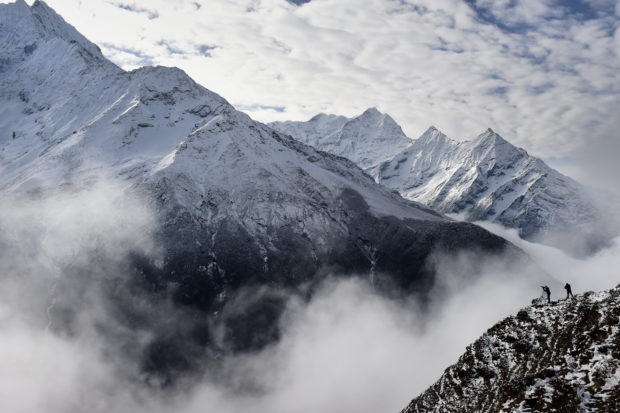8 climbers summit Mt. Everest, prepare route for hundreds
The 2018 Everest climbing season officially began on Sunday with eight high-altitude Nepali climbing guides making it to the hallowed peak. These highly-skilled mountaineers prepare the 8,848-metre peak for climbers.
Pasang Tenjing Sherpa, Pasdawa Sherpa, Lakpa Dendi Sherpa, Jen Lama, Siddi Bahadur Tamang, Pemba Chhiri Sherpa, Tenzing Gyaljen Sherpa and Datuk Bhote were the first summiteers of this season, according to Gyanendra Shrestha, official at the Tourism Ministry.
The climbers fixed the rope to the top of Everest at 3:30pm on Sunday, Shrestha said.
The rope-fixing team had aimed to complete the task on Saturday but was forced to stay at the South Col due to high winds.
“As a good weather window is expected on Monday, about 50 climbers have lined up to head for the summit,” Shrestha said from the Everest Base Camp. Last year, the Gurkha Everest Expedition had reached the top of Everest on May 15, becoming the first to scale the world’s tallest peak that year.
Article continues after this advertisementThis season, nearly 750 individuals, including 346 royalty-paying climbers, would be staking their claim on the world’s highest peak. A total of 20 Nepali climbers are among those vying to reach the summit.
Article continues after this advertisementMost of the teams have already left the base camp to prepare themselves for summit, he said. “May 14-20 is likely to be the busiest period this season.”
In the last few years, Everest has recorded a climbing success rate of 50-60 percent, according to mountaineering officials.
If things pan out well, Xia Boyu, a double amputee from China, will leave for Everest on Monday, Shrestha said, adding that the Chinese climber has reached Camp IV, the final camp situated on the South Col, and preparing the summit push on Monday.
With a large number of Everest aspirants making their attempts this season, Shrestha warns there could be a dangerous overcrowding if the climbing is delayed by bad weather.
Normally, Everest provides a roughly 15-day window for the summiteers before the monsoon begins.
On May 19, 2012, 179 individuals had reached Everest—the highest number of single-day ascents so far in a single day—due to a ‘traffic jam’ caused by a small weather window.
Climbers started arriving at the mountain’s base camp in late March. Most expeditions to Everest take around two months. Apart from 15-day climbing weather window, the climbers spend much time acclimatising themselves.
Last year, the government had issued permits to 43 groups comprising 366 royalty-paying climbers. The 2017 spring season, which ended on May 31, saw the fourth highest number of successes with 445 climbers reaching atop the summit, according to the Tourism Department data.
Among the climbers, there were 190 foreigners, 32 fee-paying Nepalis and 223 high-altitude climbing guides. There were six fatalities—two of them in the Base Camp—last year.
The government, which charges foreign climbers $11,000 each and Rs75,000 per Nepali climber, earns nearly $3.5 million in annual revenue from Everest.
The world’s highest peak was closed for two consecutive years in 2014 and 2015 due to deadly avalanches. On April 18, 2014, an avalanche near the base camp killed 16 Nepali guides. Then in 2015, quake-triggered avalanches killed 19 climbers.
The government statistics show that 5,324 mountaineers have reached the summit of Mt Everest since it was first scaled by Sir Edmund Hillary and Sherpa Tenzing Norgay in 1953.
